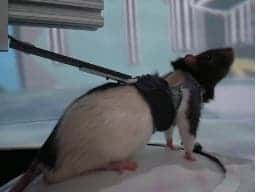Some people are better navigators than others, i.e. men better than women. Whether you can make your way effortlessly through the woods to reach a safe house or get seemingly lost on your way home from a different bus stop, it doesn’t make that much of a different at a sensory level. Navigation is often taken for granted, but the truth is it’s one of the most complex neurological function of the brain, one which requires a great of energy and complexity. This fundamental skill is paramount to avoiding threats and locating food (the reward), and through the mechanisms of evolution which promotes survival traits, it has steadily improved generation after generation.

Rat in virtual reality. (c) UCLA
The connection between spatial reasoning and reward (anticipating and actually locating food) has been very difficult to measure, mainly because current technology doesn’t permit to simultaneously study both while an animal was moving. A team of researchers at UCLA have devised, however, an ingenious multisensory virtual world for rats in order to understand how the brain processes the environmental cues available to it and whether various regions of the brain cooperate in this task.
Rats are inserted in a sort of cube, with displays on each side, and are trained to navigate their environment that changes each time through a trackball to reach their reward (sugar water). Since the animal moves on the trackball, it actually is stationary, but is offered the illusion of movement aided by visual and auditory cues.
Previously, the same team of UCLA researchers, led by neurophysicist Mayank Mehta, discovered how individual brain cells compute how much distance the subjects traveled. All animals, including humans, need to know where they’re located at a certain point in order to compare to their reference frame and navigate. Which way is left, right, up, down etc. How reward anticipation and reward seeking or navigation are connected has escaped scientists for some time.
“Look at any animal’s behavior,” Mehta said, “and at a fundamental level, they learn to both anticipate and seek out certain rewards like food and water. But until now, these two worlds — of reward anticipation and navigation — have remained separate because scientists couldn’t measure both at the same time when subjects are walking.”
Navigation requires the animal to form a spatial map of its environment so it can walk from point to point. An anticipation of a reward requires the animal to learn how to predict when it is going to get a reward and how to consume it. Mehta and colleagues, using their rat virtual environment, have now found a way to correlated the two.
The rat MATRIX
While the rats where navigating their environment in search for the reward (food), visual and auditory cues were played. When both sound and visual was played, the rats used both their legs and tongue to navigate in harmony and easily locate the feed tube. Yum! This confirmed a long held expectation, that different behaviors are synchronized. When the visual cues were shut off, and only sound was there, the rats legs seemed to be “lost” as the rodents randomly walked about, but their tongue showed a clear map of space, as if the tongue knew where the food was.
“They demonstrated this by licking more in the vicinity of the reward. But their legs showed no sign of where the reward was, as the rats kept walking randomly without stopping near the reward,” he said. “So for the first time, we showed how multisensory stimuli, such as lights and sounds, influence multimodal behavior, such as generating a mental map of space to navigate, and reward anticipation, in different ways. These are some of the most basic behaviors all animals engage in, but they had never been measured together.”
“But to our great surprise, the legs sometimes do not seem to know what the tongue is doing,” he said. “We see this as a fundamental and fascinating new insight about basic behaviors, walking and eating, and lends further insight toward understanding the brain mechanisms of learning and memory, and reward consumption.”









